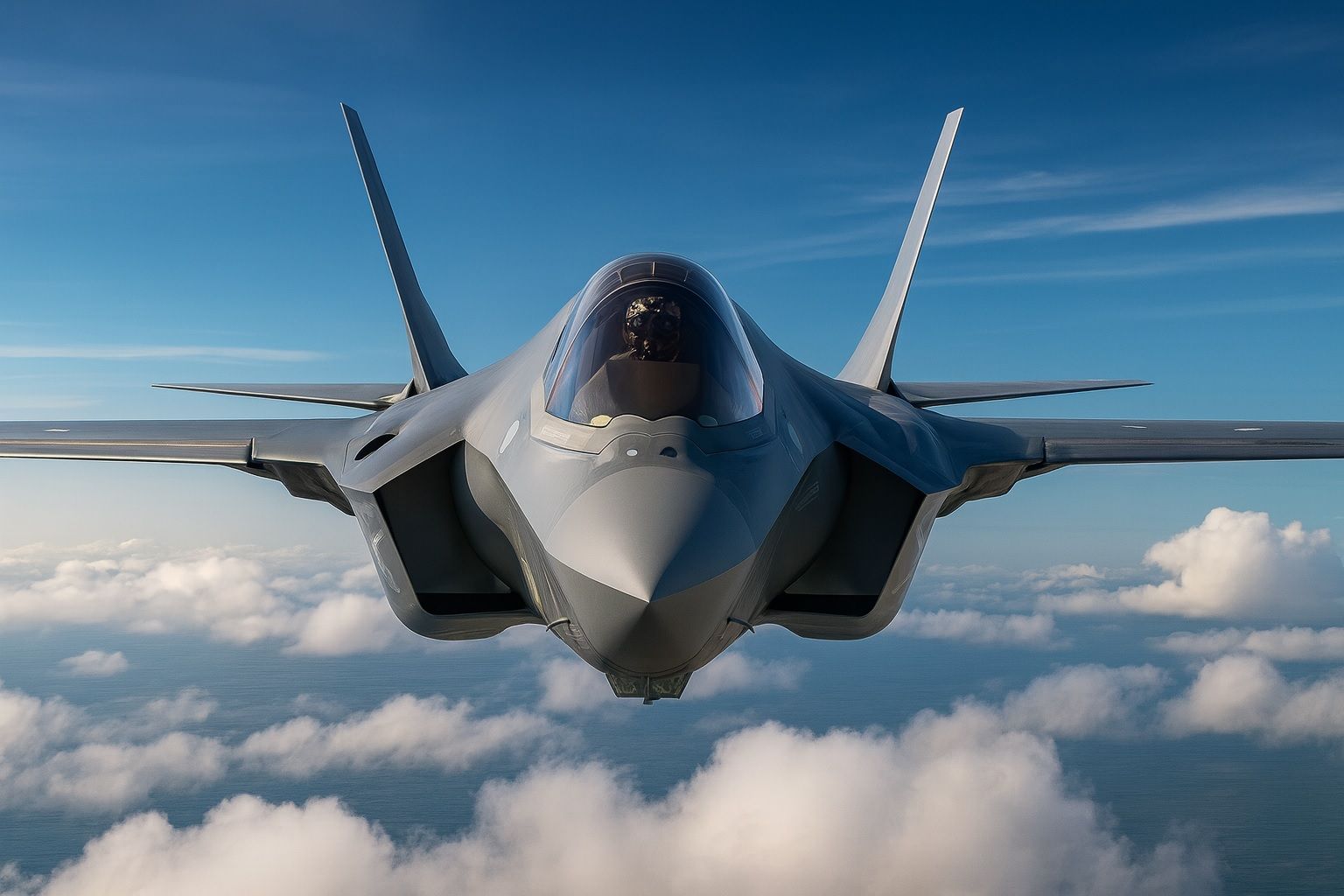- Strong Q3 Results: Lockheed Martin reported Q3 sales of $18.61 billion and EPS of $6.95, beating estimates of ~$18.56 billion and ~$6.33 [1].
- Upgraded Guidance: The company raised its full-year 2025 profit outlook to $22.15–$22.35/share (from $21.70–$22.00) and lifted lower-end sales to $74.25 billion [2].
- Huge Backlog & Contracts: Backlog hit a record $179 billion [3]. Major deals include a ~$12.5 billion F-35 jet contract (Lot 18–19), ~$11 billion for CH-53K helicopters and ~$10 billion for Patriot missiles [4].
- Defense Boom: The S&P Aerospace & Defense index is up ~34% in 2025 [5]. Sector peers Raytheon (RTX) and Northrop (NOC) are +37% and +23% YTD, respectively [6]. Morgan Stanley just upped LMT’s target to $630 (≈25% upside) on the back of its deep backlog [7] [8].
- Share Price Reaction: LMT shares jumped in premarket trading after hours. On Oct 20 they closed at $505.90, and by Oct 21 pre-market were about $518.97 (up ~2.6%) [9].
Robust Q3 Results and Increased Guidance
Lockheed Martin’s (NYSE:LMT) Oct. 21 earnings release blew past forecasts, reflecting surging military demand. Revenue rose 8.8% year-over-year to $18.61 billion and net income was $6.95/share [10]. That beat Wall Street’s $6.33/share estimate and matched analyst forecasts of about $18.56 billion. CEO Jim Taiclet highlighted the “unprecedented demand” for Lockheed products, noting a record $179 billion backlog – over 2½ years of sales [11]. In light of the strong quarter, Lockheed raised 2025 guidance. It now expects $22.15–$22.35 EPS (vs prior $21.70–$22.00) and about $74.25–$74.75 billion in revenue [12].
Jim Taiclet emphasized the scale of current demand: “Based on the effectiveness and reliability of our products…strong demand from Lockheed Martin’s customers — both in the U.S. and among our allies — continues,” he said [13]. He noted massive contracts for key programs and Lockheed’s expanding production capacity: “Major contract awards for the CH-53K and PAC-3 MSE programs are the largest ever… we finalized the contracts covering Lots 18 and 19 of the F‑35… Lockheed Martin has delivered a record 143 F‑35 Lightning II jets through the end of the third quarter.” [14]. Taiclet added that Lockheed is “investing aggressively in both new digital technologies and physical production capacity” to meet US and allied defense needs [15].
Geopolitical Demand and Major Contracts
Analysts say Lockheed’s windfall is driven by global conflicts that are inflating defense budgets. A Reuters report noted that wars in Ukraine and the Middle East have “prompted a surge in demand for missiles and fighter jets”, lifting Lockheed’s aeronautics sales 11.9% in Q3 [16]. Indeed, Lockheed has been winning massive contracts: on top of the recent F-35 deal, its Sikorsky unit snagged an $11.4 billion CH-53K helicopter order (up to 99 heavy-lift choppers) [17]. In September the US Army awarded Lockheed an all-time high $9.8 billion Patriot missile contract [18].
Lockheed’s executive and industry peers underscore this momentum. For example, Northrop Grumman raised its 2025 profit forecast on similar tailwinds, citing Middle East and Ukraine tensions [19]. Northrop’s Q3 revenue was $10.42 billion (+4%) with $7.67 EPS (vs $7.00 a year prior) [20]. Raytheon Technologies (RTX) also trumpeted strong demand: its defense unit saw a 10% sales jump (driven by Patriot missile shipments) [21]. RTX reported Q3 revenue of $22.48 billion (up 12%) and $1.70 EPS, beating estimates [22], and promptly raised its 2025 sales forecast to $86.5–87.0 billion [23].
The combined effect: traditional defense primes are on a tear. In 2025 the S&P Aerospace & Defense index has climbed ~34%, far outperforming the market [24]. Legacy contractors RTX and NOC are up roughly +37% and +23% respectively [25]. TS2.Tech notes that “Lockheed’s performance must be viewed in the context of a surging defense sector.” Industry experts observe that much of this upside is now coming from emerging areas like AI, cyber warfare, hypersonics and unmanned systems [26]. Stifel’s Jon Siegmann sums it up: “The winners…will be those leaning into the change and investing in upgradable, software-enabled systems” [27] – exactly the direction Lockheed is moving.
Analyst Outlook and Market Reaction
Wall Street’s take is mixed but generally optimistic. Morgan Stanley just upgraded Lockheed to Overweight and boosted its 12-month price target to $630 [28] (about 25% above current levels). This bullish view highlights Lockheed’s “deep backlog of missiles and fighters” amid surging military spending [29] [30]. Other firms raised targets too: Susquehanna to $590, Truist to $500, Deutsche to $519, etc. [31], although Goldman Sachs remains cautious at a $425 target.
Investors also note near-term risks. Shutdown-related uncertainty may cause defense contractors to issue conservative guidance. In fact, Morgan Stanley’s recent note advised being “buyers of tepid Defense outlooks as upward revisions should materialize as the funding picture clears up” [32]. Northrop’s jump from shutdown fears hints at this pattern – its stock and those of RTX and others rebounded as shutdown drag eased [33].
On October 21, as Lockheed reported, the market responded enthusiastically. LMT shares closed at $505.90 on Oct. 20 and spiked about 2.6% in early trading on Oct. 21 (pre-market ~$518.97) [34]. Analysts’ consensus 12-month price targets average near $520 [35], but with Lockheed’s yield (~2.7%) and aggressive buybacks, many see upside. In the company’s words, decades of dividend increases and fresh $2 billion buyback authorization show confidence that “even modest growth in sales should support further gains.” Lockheed’s disciplined capital returns—23 straight years of dividend hikes—reinforce this view [36] [37].
Bottom Line: Defense Demand Intact
Despite talk of Middle East ceasefires or budget shifts, the long-term outlook for Lockheed remains strong. The recent market wobble when peace talks emerged (Europe’s defense sector briefly dipped in early Oct) underscores how much sentiment drives these stocks. But experts warn that geopolitics haven’t fundamentally changed: NATO is still hiking budgets, stockpiles need replenishment, and new conflicts may arise. As AeroVironment’s Church Hutton observes, today’s administration is “very clear on the need for our warfighters to get the equipment they need at a much faster pace” [38].
With Q3 showing robust sales and margins, and CEO Taiclet doubling down on production, Lockheed appears poised for continued growth. “Together, these results reflect a company built for performance today and poised for growth tomorrow,” he said [39]. For now, Lockheed Martin remains at the center of the defense rally – a prime beneficiary of rising military budgets and new weapons demand. Investors will be watching its shares closely, but most industry analysts agree the tailwinds are likely to continue supporting Lockheed’s shares into 2026 [40] [41].
Sources: Lockheed Martin press release [42]; Reuters [43] [44] [45]; AP/SeattlePI [46]; TS2.Tech analysis [47] [48]; Investopedia [49]; StockAnalysis data [50]; Marketscreener.
References
1. www.seattlepi.com, 2. www.reuters.com, 3. news.lockheedmartin.com, 4. www.reuters.com, 5. ts2.tech, 6. ts2.tech, 7. ts2.tech, 8. ts2.tech, 9. stockanalysis.com, 10. www.seattlepi.com, 11. news.lockheedmartin.com, 12. www.reuters.com, 13. news.lockheedmartin.com, 14. news.lockheedmartin.com, 15. news.lockheedmartin.com, 16. www.reuters.com, 17. ts2.tech, 18. ts2.tech, 19. www.reuters.com, 20. www.reuters.com, 21. www.investing.com, 22. www.investing.com, 23. www.investing.com, 24. ts2.tech, 25. ts2.tech, 26. ts2.tech, 27. ts2.tech, 28. ts2.tech, 29. news.lockheedmartin.com, 30. ts2.tech, 31. ts2.tech, 32. www.investopedia.com, 33. www.investopedia.com, 34. stockanalysis.com, 35. stockanalysis.com, 36. news.lockheedmartin.com, 37. ts2.tech, 38. ts2.tech, 39. news.lockheedmartin.com, 40. ts2.tech, 41. ts2.tech, 42. news.lockheedmartin.com, 43. www.reuters.com, 44. www.reuters.com, 45. www.investing.com, 46. www.seattlepi.com, 47. ts2.tech, 48. ts2.tech, 49. www.investopedia.com, 50. stockanalysis.com







